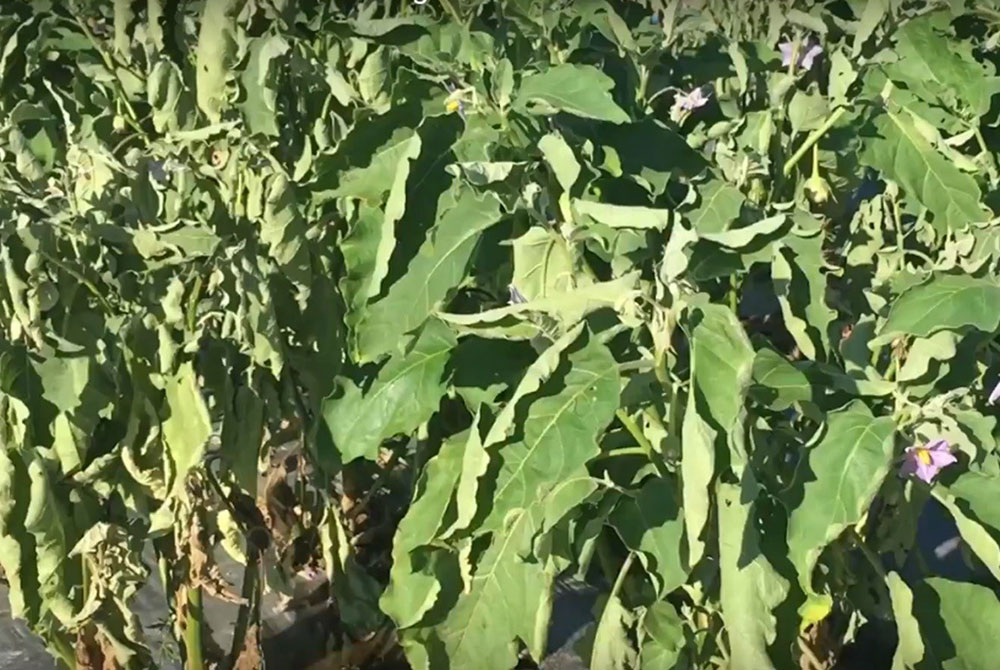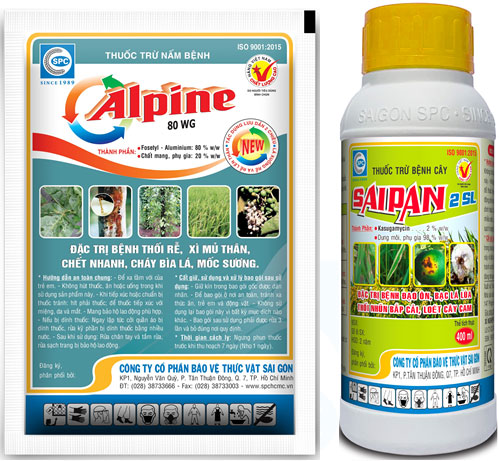|
Bacterial Wilt Disease On Eggplant
31/07/2021
Ph.D Nguyen Minh Tuyen Bacterial wilt is a fairly common disease for eggplant plants, especially when the weather is hot and humid. Eggplant wilt disease is especially common in specialized cultivation areas, or areas specializing in growing vegetables such as tomatoes, chili peppers, etc. for many years. Currently, bacterial wilt on eggplant is still a difficult disease for growers. * Symptoms and effects: The disease can occur during most growth stages of eggplant, but is more common in the fruiting stage. Plants that are still green naturally wilt suddenly during the day, especially in the late afternoon period. At night and early in the morning, the tree will be green again if the disease is still mild, but the tree will die wither when the disease is severe. The disease can cause the tree to die in clusters and wide spread if there are no timely and proper prevention measures.
* Pathogens and conditions of development: Eggplant bacterial wilt disease caused by Pseudomonas sp. The disease develops in tropical egg plant growing areas. Soil with many remnants of previous crop, low humus and low-lying soil, high density of tomato cultivation, excess nitrogen fertilization, dense trees, low humidity, garden with many pests, especially soil-dwelling species such as white grub ,striped flea beetles, crickets, nematodes... cause wounds in the roots, the disease is easy to develop. Poor water management also aggravates the disease. * Highly effective management measures: The principle is to apply a combination of measures: - Cleaning the remnants of the previous crop. If the garden is often damaged, it is necessary to treat the soil before planting for worms, striped flea beetles, nematodes... that damage the roots. - Raise a high bed so that the soil and garden are well ventilated. Do not make the soil too small, do not compact the soil when planting, because the soil will easily crack after planting and will break the roots. - Apply enough manure (has been composted and thoroughly treated with Trichoderma) for loose soil to prevent cracking when dry, balanced and adequate fertilizer application, avoiding excess nitrogen for healthy plants and disease resistance. - Use disease-resistant varieties and healthy seedlings in reliable establishments to limit disease. - Plant eggplant with appropriate density, avoid dense to the garden ventilation. - When caring, avoid damaging and breaking the roots. - Water well, limit the garden too wet, or too dry. Do not let the water regime change suddenly, which can easily break the roots. - When a diseased plant is detected, it should be uprooted and destroyed. - When the garden is often seriously ill, it should be rotated with other crops. - Before the flowering stage, if the garden has ever suffered from green wilt disease, it is necessary to spray and irrigate preventively with drainage and internal absorption products such as Alpine 80WG or Saipan 2SL.
|
To prevent, in addition to plowing and burying weed seeds, collecting weed stalks and stumps left after tilling the land to burn, not letting weeds produce seeds in production fields, etc., the use of chemical products is still a measure. optimal because of its ability to thoroughly kill weeds, reduce labor and take advantage of more time than manual weeding.
Miner has the scientific name Phyllocnistis citrella Staint., family Phyllocnistidae, order Lepidoptera. The miner occurs in many countries in the tropics and subtropics. The main host of the miner is the citrus family - Rutaceae. In addition, the miner also attacks mangosteen and some other plants.
Adult is a small planthopper, with a body 2-3 mm long, the whole body is ash gray, slightly greenish, the wings are opaque with many small brown spots.Eggs are oval, 0.3 mm long, have a pointed end and are attached directly to the leaf surface, leaf axils.
Green bugs specialize in the fruit of citrus groups (oranges, tangerines, lemons, grapefruits, kumquats...), some people call them orange bugs, or orange suckers. Their scientific name is Rhynchocoris poseidon or Rhynchocoris humeralis.
In Vietnam, yellow leaf curl disease is very common on papaya trees, especially the disease is often severe in areas of high and continuous planting, areas with hot and arid climates. The disease has significantly reduced the yield and quality of papaya. Gardens that are infected early when the plants are young may not yield. However, up to now, many gardeners still do not know the cause and how to fix it.
Spider mites are common pests on citrus trees, especially in hot and dry climates that are suitable for spiders to grow and cause severe damage.The group of harmful spiders is usually very small in size, unlike the natural enemy spiders.
This group includes species that are generally very small in size, causing damage by sucking plant sap (on leaves, fruits, branches, stems).
There are many species of mealybugs present on the group of Oranges,Tangerines,Grapefruits and Lemons (Citrus), which can be divided into 2 groups:
+ Group of sticky mealybugs with common varieties such as Lepidosaphes, Aonidiella, Coccus and Saissetia.
+ Group of flower mealybugs with common genera and species such as Pseudococcus, Planococcus and Icerya purchasi.
Dry branches and berries disease often appear to be common damage on coffee gardens during the rainy season. The disease causes death of branchs, dry fruit, severely affects the canopy structure and coffee yield if not paid attention to prevention.
Pink disease commonly causes diseases on rubber plantations in the rainy season, especially on garden from 4-8 years old. This year, rubber has to go through a period of severe drought, weakening the tree, so now in tnshe rainy season it is easy to get infected. Therefore, it is necessary to pay attention to good management to avoid affecting the garden.
In recent years, the area of citrus has been expanded because it is a fruit tree with high economic efficiency. However, in order to sell at a high price, not only in quality but consumers also require the external beauty of the fruit, so pest management on citrus is a matter of great concern to farmers. The hot season is a favorable condition for thrips to develop and cause damage, affecting the commercial value of fruit.
- Headquarters
- SAIGON PLANT PROTECTION JOINT STOCK COMPANY
- RQ 1, Nguyen Van Quy St., Tan Thuan Ward, HCM City
- Tax code: 0300632232
- Tel: (028) 38 733 295 - 38 732 077
- Fax: (028) 38 733 003 - 38 733 391
- Website: www.spchcmc.vn - Email: info@spchcmc.vn
- SAIGON PLANT PROTECTION COMPANY
- SAIGON PLANT PROTECTION JOINT STOCK ENTERPRISE
- Lot C1-C3 Hiep Phuoc Industrial Park, Hiep Phuoc Commune, HCM City
- Tel: (028) 3873 4089 - Fax: (028) 3873 4086
- Affiliated Unit
-
- Quick Links
- Home
- About us
- Career Opportunities













